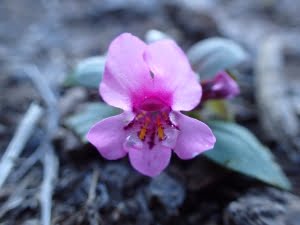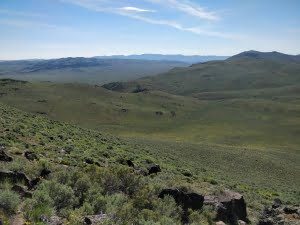
Two hours from nowhere: monitoring remote sagebrush ecosystems in Eastern Oregon
By Lisa Schomaker and Kaitlyn Harless
February 2020
Eighty miles from cell service and ten miles off the highway, on a bumpy track just north of the Nevada state line, botanical monitoring technician Kaitlyn Harless saw her first herd of pronghorn (Antilocapra americana) in the wild. Not long after, a wild horse (Equus ferus) galloped over the sagebrush-coated hills. And following an early summer flurry of snow showers, she uncovered her first dwarf purple monkeyflower (Mimulus nanus, Figure 1). It was a summer of firsts not only for Kaitlyn, a Virginia native and recent graduate of James Madison University, but also for IAE as we collaborated with the Lakeview District of the Bureau of Land Management (BLM) to initiate our eastern Oregon Research Natural Area (RNA) monitoring project. IAE’s Sagebrush in Prisons Project has actively contributed restoration support to Greater Sage-Grouse (Centrocercus urophasianus) conservation goals in the region for over 5 years. The new data collected by IAE's Conservation Research team will enhance further conservation and restoration efforts in eastern Oregon, and in sagebrush ecosystems throughout the Intermountain West.
Research Natural Areas (RNAs) are parcels of public land that have experienced minimal Anglo-European human influence or have been allowed to naturally regenerate from disturbed states. These areas are designated to allow natural processes to occur with minimal active management. There are over 500 RNAs throughout the United States, and they are managed and monitored by multiple federal land management agencies including the BLM, the National Park Service, and the Fish and Wildlife Service. While serving as laboratories for long-term studies of ecosystem change, they also provide functional comparisons for areas in similar ecosystems that are more heavily manipulated by humans.
At both of these sites, we inventoried all present plant species and gathered plant community structure measurements along several transects designed for long-term monitoring. These data will be used both to track changes in plant populations and community structure over time and in concert with changing climate regimes, and to inform future management actions. By understanding how and why our natural environments change across decadal time scales, we improve our ability to predict how ecosystems may change into the future, and with that, our ability to preserve them, the biodiversity therein, and the services they provide.
One of the most rewarding aspects of field work lies in unexpected discovery. Beneath the often gray landscape of endless sagebrush steppe, a whole world of other plants, animals, insects, and microbes thrive. Kaitlyn’s favorite plant encounter this season was with the bitterroot (Lewisia rediviva), a standout beauty when in bloom (Figure 3a), but more representative of a lobster claw as its bud emerges from the barren desert floor (Figure 3b). I enjoyed our evenings among the calls of nighthawks and burrowing owls, and waking to snow-dusted transects. In 2021, the Conservation Research team will continue the project with more surveys in RNAs throughout Eastern Oregon. IAE thanks the BLM Lakeview District for collaborating on this effort!
Restoration
Research
Education
Contact
Main Office:
4950 SW Hout Street
Corvallis, OR 97333-9598
541-753-3099
info@appliedeco.org
Southwest Office:
1202 Parkway Dr. Suite B
Santa Fe, NM 87507
(505) 490-4910
swprogram@appliedeco.org
© 2025 Institute for Applied Ecology | Privacy Policy





